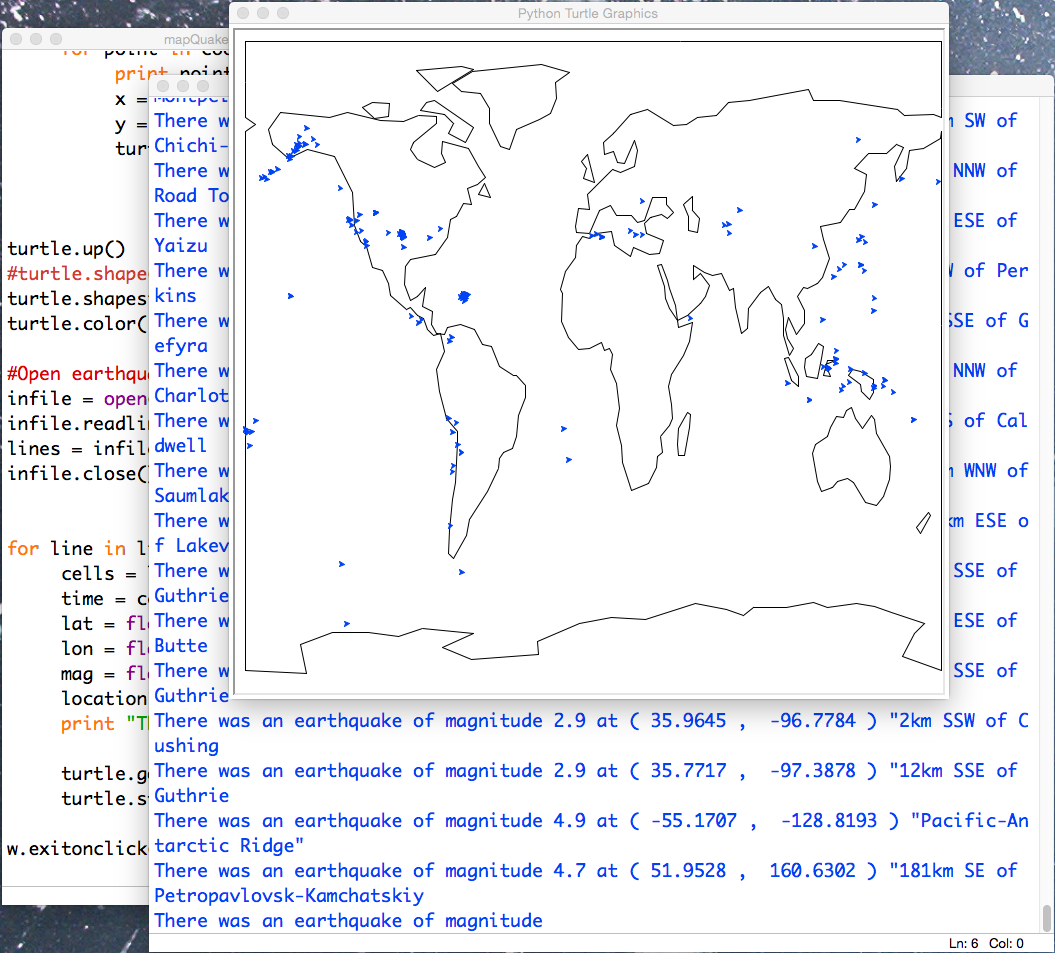

Today's lab will focus on looping through strings and files.
Software tools needed: web browser and Python IDLE programming
environment.
The simplest way to get input for our programs is via the console. We can prompt the user to enter information and store that information in a variable to be used in our program.
For example, here is a simple program that asks the user for his name and then says hello (multiple times):
Python displays the message from the input() command, and the words (or "string") the user enters is stored in the variable name.
Since Python doesn't know what you will be entering (number, words, etc.), it stores everything as a string, and leaves it to the user to convert it to what they want. For example, if we wanted a number, we need to convert the letters the user used into a number. The basic conversion functions are:
Work through the examples in 2.3 Type conversion functions and 2.4 Variables. Try the quizzes at the end of the section to test your understanding.
Let's use input to modify our output. Below is a simple turtle program:
import turtle ty = turtle.Turtle() for count in range(5): ty.forward(75) ty.left(144)
What will it do? Guess, and then try running to see.
Let's say we want to draw in a different color. The Turtle class has many functions. We have seen several: for example forward(), left(), and right(). To change color, we can use: color(). The input is the color, as a string-- to indicate that to Python, we surround the letters by quotes. So, if we wanted ty to draw in red:
ty.color("red")
or more esoteric colors like light steel blue:
ty.color("lightsteelblue")
Python knows many colors by name-- here's a list (others we can specify by the amount of red, blue, and green in the color).
Let's say we want to we want to give the user of our program the ability to control the color. We can:
#Asking and storing happen on the same line:
turtleColor = input("Please enter your color: ")
#Setting the color:
ty.color(turtleColor)
Add these lines to our program. Test it, add in your introductory comments, and submit as Problem #12.
For today's lab, we're going to write a very simple Tic-Tac-Toe program. Our first program will allow the user to specify moves. As we learn more programming over the semester, we extend this program to check who wins and to make sure the user specifies legal moves uture versions of this program.
The first thing we need to do for Tic-Tac-Toe is to draw the game board:
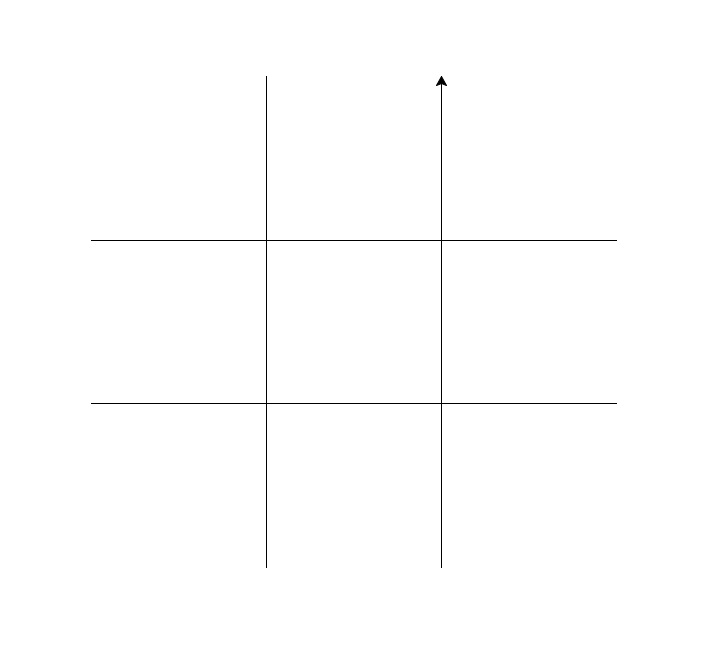
To do that, we need our turtle to draw 2 horizontal lines, followed by 2 vertical lines. To make calculating where to draw easier, we will reset the coordinates so that the x-values range from -0.5 to 3.5 and the y-values also range from -0.5 to 3.5.
#Introductory Program, Spring 2015
#Lehman College, City University of New York
#First Version of Tic-Tac-Toe
# This version does NO checking of anything (it doesn't
# check who wins, doesn't check for legal entries, etc).
# We will add that later in the semester
from turtle import *
#Set up the screen and turtle
win = Screen()
tic = Turtle()
tic.speed(10)
#Change the coordinates to make it easier to translate moves to screen coordinates:
win.setworldcoordinates(-0.5,-0.5,3.5, 3.5)
#Draw the horizontal bars of the game board:
for i in range(1,3):
tic.penup()
tic.goto(0,i)
tic.pendown()
tic.forward(3)
#Draw the vertical bars of the game board:
tic.left(90) #Point the turtle in the right direction before drawing
for i in range(1,3):
tic.penup()
tic.goto(i,0)
tic.pendown()
tic.forward(3)
main()
Save this file to your USB or MyDocuments folder and run the
program. The first block of code sets up a turtle, called tic and a graphics window called win. We will use tic to draw the lines of the game board as well as mark the players moves.
The next section uses a for-loop with values for i ranging over 1,2 (from the start value of 1 upto but not including the stop value of 3). Each time it moves to the point (0,i) and goes forward (drawing a line as it goes) 3 steps. The up and down commands lift up and put down the drawing pen, respectively.
The second for-loop is similar. To make the turtle draw vertical lines, we turn the turtle 90 degrees to the left before starting our loop.
Add to your program (after the second for-loop, but before the invocation of main() at the end of the file):
#Data Analysis, Spring 2017
#Lehman College, City University of New York
#First Version of Tic-Tac-Toe
# This version does NO checking of anything (it doesn't
# check who wins, doesn't check for legal entries, etc).
# We will add that later in the semester
import turtle
#Set up the screen and turtle
win = turtle.Screen()
tic = turtle.Turtle()
tic.speed(10)
#Change the coordinates to make it easier to translate moves to screen coordinates:
win.setworldcoordinates(-0.5,-0.5,3.5, 3.5)
#Draw the horizontal bars of the game board:
for i in range(1,3):
tic.penup()
tic.goto(0,i)
tic.pendown()
tic.forward(3)
#Draw the vertical bars of the game board:
tic.left(90) #Point the turtle in the right direction before drawing
for i in range(1,3):
tic.penup()
tic.goto(i,0)
tic.pendown()
tic.forward(3)
tic.penup() #Don't need to draw any more lines, so, keep pen up
#Ask the user for the moves, alternating between the players X and O:
for i in range(4):
x = int(input("Enter x coordinate for X's move: "))
y = int(input("Enter y coordinate for X's move: "))
tic.goto(x+.25,y+.25)
tic.write("X",font=('Arial', 90, 'normal'))
x = int(input("Enter x coordinate for O's move: "))
y = int(input("Enter y coordinate for O's move: "))
tic.goto(x+.25,y+.25)
tic.write("O",font=('Arial', 90, 'normal'))
#Display an ending message:
tic.goto(-0.25,-0.25)
tic.write("Thank you for playing!",font=('Arial', 20, 'normal'))
win.exitonclick()#Closes the graphics window when mouse is clicked
Our for-loop here is a bit more complicated. Lets go through it line by line:
tic.penup() #Don't need to draw any more lines, so, keep pen upWe lift up the pen before starting the loop, since we don't need to draw any more lines (just write text to the screen).
#Ask the user for the moves, alternating between the players X and O: for i in range(4):The range only has a single input parameter, so, it defaults to starting at 0 and going upto, but not including the number 4, yielding the sequence of 0,1,2,3. Our first time through the loop i will be 0, the next time it will be 1, and we keep going until the last time it is 3.
x = int(input("Enter x coordinate for X's move: "))
y = int(input("Enter y coordinate for X's move: "))
tic.goto(x+.25,y+.25)
tic.write("X",font=('Arial', 90, 'normal'))
These next lines ask the user to enter the x, y coordinates. The program is using the following coordinates for the squares:
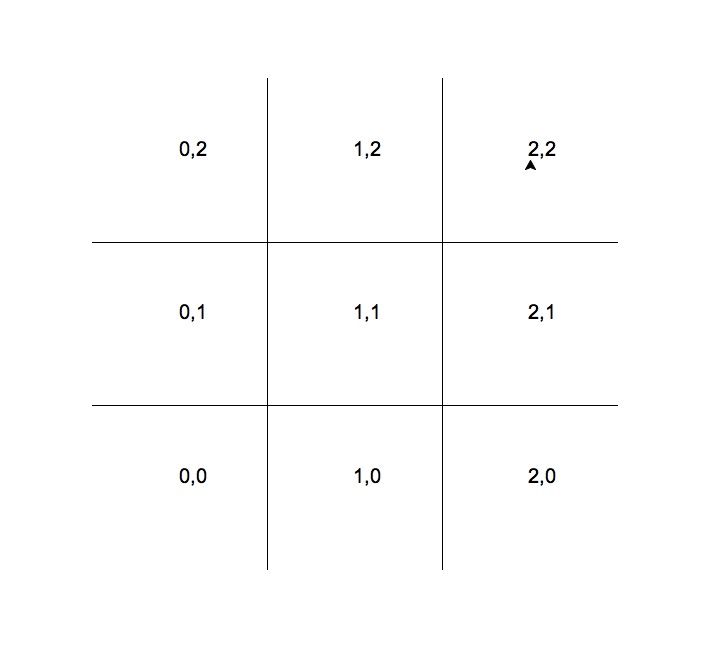
At the Python shell, if the user entered 0,0:
Enter x, y coordinates for X's move: 0,0Then tic would move to (0+.25, 0+.25) = (0.25,0.25) and write out a large X (the .25 are added to make the marks a bit more centered on the game board). The graphics window would display:
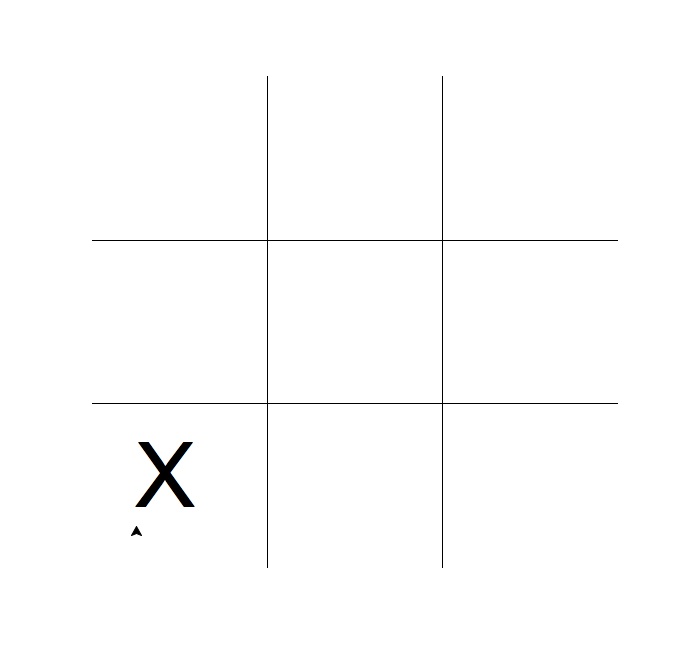
The next part of the body of the for-loop asks for the second player's move:
x = int(input("Enter x coordinate for O's move: "))
y = int(input("Enter y coordinate for O's move: "))
tic.goto(x+.25,y+.25)
tic.write("O",font=('Arial', 90, 'normal'))
and draws an O to the screen where they indicated.
The for-loop will repeat 4 times. Each time, it asks the first user for a move and the second user for the move. Here is sample run of the program:
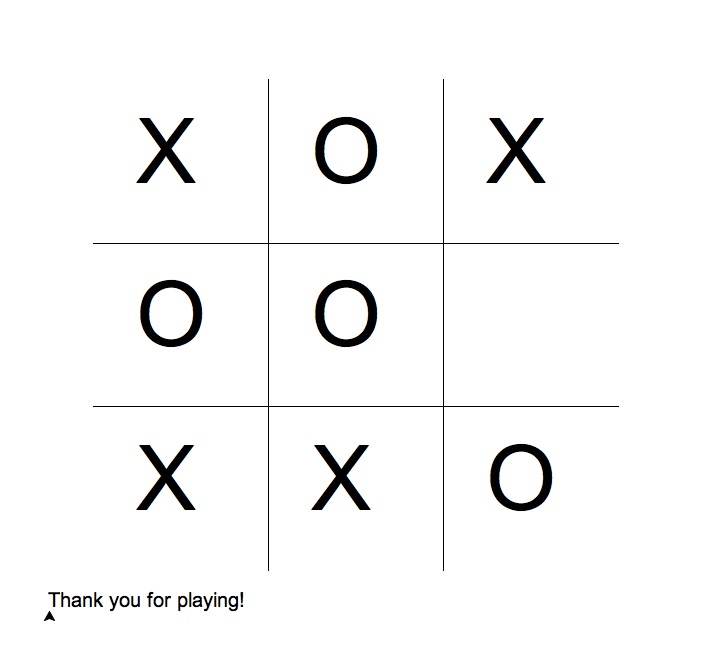
The moves are entered on the Python shell and displayed on the graphics window. Some challenges to try (ask your instructor for hints if you do not see how to do these, since questions like these will appear on quizzes and exams):
Note: as we learn more programming, we will add to this program to have it check if the players entered legal moves and also to check to see if a player has won the game (by having three in a row, horizontally, vertically, or on the diagonals).
#Data Analysis, Spring 2017
#Lehman College, City University of New York
#First Version of Tic-Tac-Toe
# This version does NO checking of anything (it doesn't
# check who wins, doesn't check for legal entries, etc).
# We will add that later in the semester
import turtle
#Set up the screen and turtle
win = turtle.Screen()
tic = turtle.Turtle()
tic.speed(10)
#Change the coordinates to make it easier to translate moves to screen coordinates:
win.setworldcoordinates(-0.5,-0.5,3.5, 3.5)
#Draw the horizontal bars of the game board:
for i in range(1,3):
tic.penup()
tic.goto(0,i)
tic.pendown()
tic.forward(3)
#Draw the vertical bars of the game board:
tic.left(90) #Point the turtle in the right direction before drawing
for i in range(1,3):
tic.penup()
tic.goto(i,0)
tic.pendown()
tic.forward(3)
tic.penup() #Don't need to draw any more lines, so, keep pen up
#Ask the user for the moves, alternating between the players X and O:
for i in range(4):
x = int(input("Enter x coordinate for X's move: "))
y = int(input("Enter y coordinate for X's move: "))
tic.goto(x+.25,y+.25)
tic.write("X",font=('Arial', 90, 'normal'))
x = int(input("Enter x coordinate for O's move: "))
y = int(input("Enter y coordinate for O's move: "))
tic.goto(x+.25,y+.25)
tic.write("O",font=('Arial', 90, 'normal'))
#Display an ending message:
tic.goto(-0.25,-0.25)
tic.write("Thank you for playing!",font=('Arial', 20, 'normal'))
win.exitonclick()#Closes the graphics window when mouse is clicked
If you finish the lab early, now is a great time to get a head start on the programming problems due early next week. There's instructors to help you and you already have Python up and running. The Programming Problem List has problem descriptions, suggested reading, and due dates next to each problem.